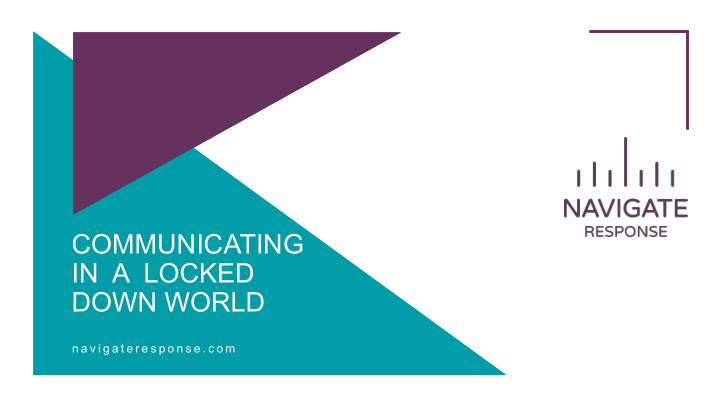



COMMUNICATING IN A LOCKED DOWN WORLD n a v i g a t e r e s p o n s e . c o m n a v i g a t e r e s p o n s e . c o m
2 COVID-19 HAS TAKEN OVER THE MEDIA 1.028 Million 24 March 2020 Global media coverage of COVID-19 in 2020 Daily articles published by recognised media outlets
3 COVID-19 IN THE TRADE PRESS 184 articles 19 March 2020 Maritime media coverage of COVID-19 in 2020 Daily articles published
4 THE AGE OF SOCIAL MEDIA Instagram impressions up 26% TikTok engagement up 27% Facebook traffic 10-12% above New Year’s Eve peaks Employees in isolation and seafarers unable to return home are likely to be especially active Educate employees about safe use Do not be seen to be trying to control or censor
5 IS IT A GOOD TIME TO BE A JOURNALIST? Readership is way up – especially female readership Online subscriptions are rising at four to six times normal rates (according to the Economist) BUT Print circulation is expected to drop by 30% in the UK Advertising revenue way down Fewer journalists covering more stories
6 YOUR STORY WITH A BUSY JOURNALIST Less time for research Potentially easier to hide something – don’t be tempted, the truth is always best Mistakes more likely Follow up stories less likely – you have one chance to get the record right Much harder to get a correction The ”easy” version of the story even more likely to “win” Communicators need to do our jobs better than ever
7 JOURNALISTS AREN’T DOING THIS NOW
8 WHERE COMMUNICATIONS HAPPENS 95% 5% Telephone Press conference Email In studio Twitter On location Website Other in person
9 83% OF JOURNALISTS USE TWITTER
10 TRUSTING TWITTER Young journalists and those who use Twitter extensively ranked some tweets as more newsworthy than headlines from the Associated Press in a study by Columbia School of Journalism. 32 out of 33 major American news outlets have embedded tweets from fake Twitter accounts without identifying them as such. Journalists can see a story as important because other journalists on Twitter are talking about it, rather than because it is newsworthy.
11 COMMUNICATING DIRECTLY WITH AUDIENCES
12 WHAT’S THE COVID-19 ANGLE ON YOUR SITUATION? Will determine: • Size of story • Lines of questioning • Success or failure • Prepare your Q&A accordingly
13 REMOTE MEDIA BRIEFINGS Increasingly popular with many companies Easier to control timelines than a ‘live’ physical briefing Invite list not defined by geography, but by topic and time zone Can appear less personal – take time to fully respond Have an MC or “Gate-keeper” if possible Need for ID pre-question is essential – Name and News Org
14 HOW YOU BRIEF IS POLITICAL – BE AWARE
15 HOW TO PREPARE Track usual indicators of likely media interest Highly visible? Connected to a larger story? Recognizable names/brands involved? People could ‘feel’ impacted? Track COVID-19 coverage cycle Don’t get complacent Have support resources on standby (internal or external)
16 WILL CHANGE SUDDENLY COVID-19 fatigue Media attention saturation Craving pictures - COVID-19 is not photogenic Who will be the unlucky breakout story?
17 T H A N K Y O U ! Dustin Eno
Recommend
More recommend